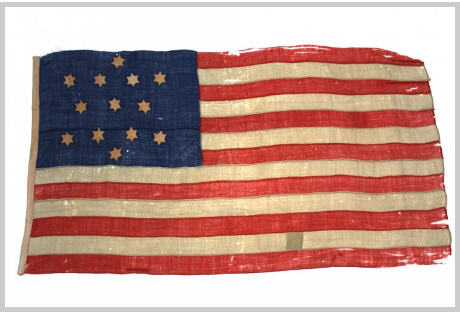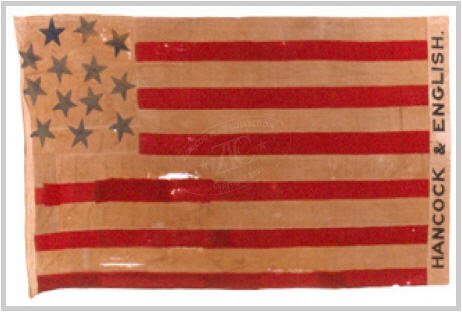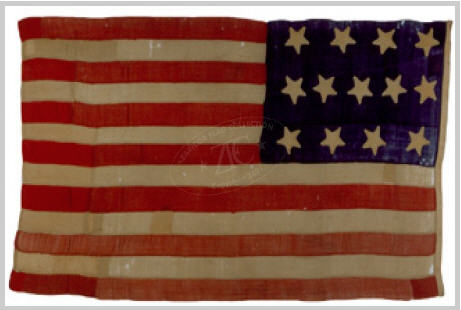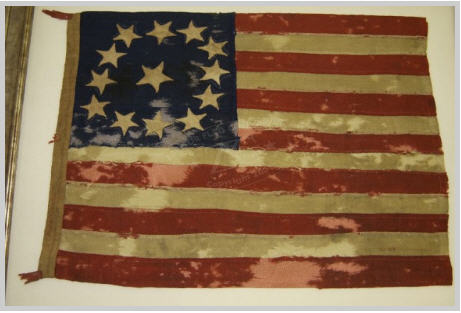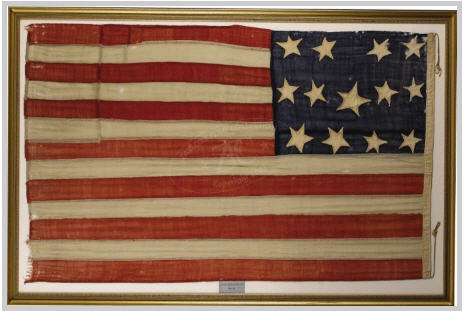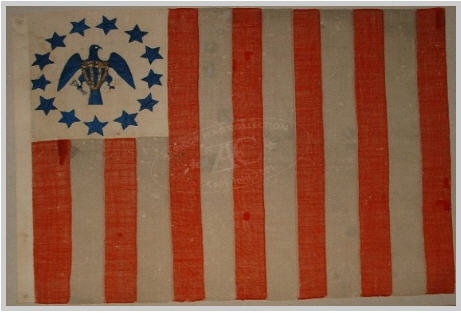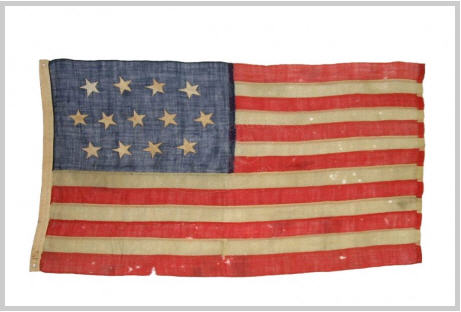Period 13 Star United States Flags
Click on the image below to enlarge it.
Revolutionary & Federal Period 13-Star Flags
Click on each image for more details
ZFC0604 13 Star U.S. Flag - Grand Luminary design from the Revolutionary & Early Federal Period. This 13 star Grand Luminary is made of wool bunting with 13, six-point, linen stars in the canton, which forms a Grand Luminary of six points. A large six pointed star formed from 13 smaller ones has been a distinctive feature of the US Arms and Great Seal since 1782 and this early Federal Period flag incorporates such a design on its canton.
These characteristics point to manufacture during the early federal Period; especially the six-pointed linen stars, a common with 18th century flags. This flag is unique, and is thought to have been used during the 21 months New York City served as our nation's capital from the 4th of March 1789, to the 5th of December 1790, and possibly before.
ZFC0624 13 Star U.S. Flag, Revolutionary & Early Federal Period. This striking flag from Salem, MA, is now often referred to as the "Hancock English Flag," because of the 1880 presidential election campaign panel added to the fly edge. It is a period 13 star flag.
One of the few in existence, vernacular flags like this one were the norm between 1777 and 1795, when this star count was up to date. While ship's chandlers routinely provisioned flags for maritime and naval use, local governments, the militia and private citizens were left to their own devices when a flag was required.
Such a star pattern (single ring of nine with four center stars) is identical to the canton on the flag of the Bucks of America, a Massachusetts militia unit comprised of freemen of color who were presented such a flag in the late1780s. This factor suggests use of this particular example during the revolutionary era.
ZFC0707 United States, 13 Star flag from the Privateer Minerva, during the Revolutionary War era. It is from the acclaimed collection of Boleslaw Mastai. According to Boleslaw Mastai, it is believed to be the only named ship's ensign to have survived. When the 13 United Colonies declared their independence from Britain, the fledgling Continental Navy had few ships commissioning a meager 31 ships. To augment the small American fleet, Letters of Marque were issued to private armed merchant vessels like the Minerva. Commissioned as privateers, they preyed on enemy merchant vessels.
Dudley Saltonstall (1738-1796) was a Boston captain, merchant, and privateersman in the French and Indian War. As a Captain of the Continental Navy during Revolutionary War, he was given command of the Alfred, flagship of Commodore Esek Hopkins, which effectively raided and sacked munitions stored at New Providence in the Bahamas. In 1779, as Commodore of the disastrous Penobscot Expedition, he was made responsible and dismissed from the Navy. But privateering proved to be a profitable option for a ships captain willing to take risks. After the Revolutionary War, this flag passed to a shipmate and friend of Saltonstall's, Captain John Spear, who preserved this flag.
ZFC0715 13 Star U.S. Flag - Single Ring with Center Star from the Revolutionary & Early Federal Period. Most Americans are familiar with the so-called Betsy Ross Flag, a United States flag bearing 13 stars arranged into a single ring or circle. This flag is commonly accepted as the first United States flag dating from 1777, but this has not been documented. A review of the historic data also reveals that there are no surviving period flags in this design and the earliest known image is dated to 1782. Instead, it is highly likely that in the 18th century, some U.S. flags bore a single ring and a center star like this well-worn example, which is similar in design to other, documented 13 star flags from the 1780s. The linen and cotton construction of this flag are also indicative of 18th century manufacture.
ZFC2497 13 Star US Flag, four-five-four star pattern design with a large center star, Early Federal Period. This wool, 4-5-4 star pattern, 13 Star United States Flag, is one of the earliest documented American flags in existence. From the Old Sandy Point Light House, New York in 1790, it was made shortly after the federal government was formed. The Sandy Hook Lighthouse is the oldest working lighthouse in the United States. After the Revolutionary War, a dispute over dominion of the lighthouse broke out between New Jersey and New York, however Congress resolved the dispute when on August 7, 1789, they gave control of all lighthouses to the federal government. Lighthouses thus became one of the first civil establishments that needed to be identified as federal, rather then state, in jurisdiction.
This flag was from the Crow Art Partnership Collection.
ZFC2407 13 Star U.S. Revenue Marine Ensign & Customhouse Flag 1799.
This flag is believed to be the oldest surviving U.S. Revenue Marine Ensign and Customhouse flag. It is hand-sewn with an open weave wool bunting for the stripes over a silk canton. This flag is either a variant of or precursor to the 1799 regulations and reflects the local flag maker's interpretation of the arms of the United States. The presence of metallic ribbon, fine embroidery details, and the use of silk threads in the canton it is unlikely that this flag was ever actually used as an ensign. It is more likely that this flag was flown onshore at a US Customs office or customhouse. Curiously, this flag has only 13 vertical stripes and is therefore not in compliance with the 1799 design; but all of the Revenue Marine flags were locally supplied until 1862. Accordingly, variants of the 1799 regulations like this are thought to be the norm rather than the exception.
ZFC0419 13 Star U.S. Merchant Ensign, 4-5-4 Star design, Early Federal Period. This flag may well be one of the earliest United States flags in the Zaricor Flag Collection. While the use of cotton stars suggests the possibility of production after 1800, recent scholarship points to the existence and use of cotton threads prior to 1793. The woolen stripes have selvedges typical of early hand-loomed material and the flag is hand-stitched.
The finishing details indicate that a professional made this flag. One can see this in the finely crafted linen hand whipped-stitched eyelets on the hoist. Interestingly, the marking 1 1/2 on the flag's cotton heading refers to a flag manufactured to a specific fly dimension; in this case one and a half yards, or 54".
The size marking on the heading is more typical of flags manufactured as stock items rather than by special order. One of the earliest identified flag manufacturers in the United States was Rebecca Young of Philadelphia and Baltimore. She advertised in local newspapers that she had, on hand, ready-made flags and this flag might well be one of her products.
ZFC1495 13 Star U.S. Flag – very early all cotton flag. This flag was represented at an auction as being a 13-star flag from the Revolutionary period (1777-1783). When this flag was examined by a textile expert, it was determined that the materials were in accord with those available in the 18th century and the construction techniques used point to the 18th century. This 13 star flag warrants further study and analysis because what we previously believed was a flag from the 1800s has, in fact, attributes dating to the late 1700s, making it a period 13 star flag from the Federalist period and possibly the Revolutionary War.
One of the few in existence, vernacular flags like this one were the norm between 1777 and 1795, when this star count was up to date. While ship's chandlers routinely provisioned flags for maritime and naval use, local governments, the militia and private citizens were left to their own devices when a flag was required.
Such a star pattern (single ring of nine with four center stars) is identical to the canton on the flag of the Bucks of America, a Massachusetts militia unit comprised of freemen of color who were presented such a flag in the late1780s. This factor suggests use of this particular example during the revolutionary era.




